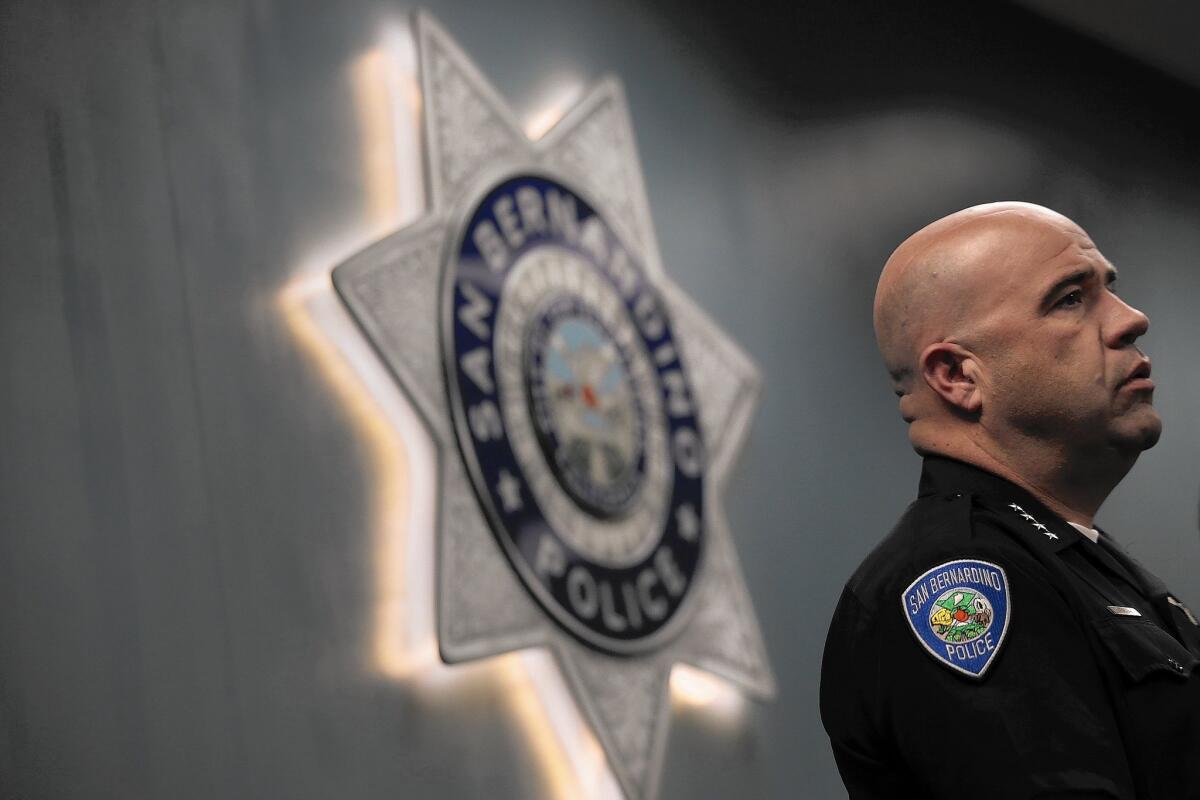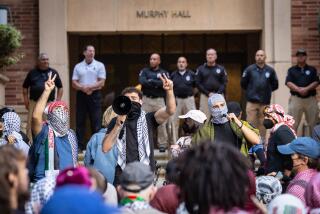San Bernardino police are praised for attack response but know not everything went smoothly

San Bernardino police have been widely commended for their quick and effective response to the Dec. 2 terrorist attack. Within four hours of the mass shooting that left 14 people dead, the suspects had been tracked and were later killed in a gun battle.
But when San Bernardino Police Chief Jarrod Burguan reflects on what happened in those frantic hours, he knows not everything went smoothly.
“We’ve had a lot of people who have come to us and they’ve said this appeared to be a perfect response or a textbook response, and I think a lot of that is a byproduct of how it ended,” Burguan said last week. “But we know that internally we still had some pretty chaotic things going on.”
Officers who responded to the worst terror attack on U.S. soil since Sept. 11, 2001, have asked Burguan to consider several changes to help police respond in similar situations, the chief said.
They include improving medical training and supplies, buying more rifles and equipping officers with body armor that protects against rifle fire.
Syed Rizwan Farook and his wife, Tashfeen Malik, were armed with semiautomatic rifles when they entered a gathering of county health employees at the Inland Regional Center and opened fire.
Last week, the Police Foundation, a Washington, D.C., research group, began a U.S. Justice Department-funded review of the response to the shooting. The group reviewed police actions during the 2013 manhunt for Christopher Dorner, praising police but also highlighting significant shortfalls.
Robert Chapman, deputy director of the Justice Department’s Community Oriented Policing Services, said the review is meant to help train law enforcement in the event of future attacks.
A lot of people ... have ... said this appeared to be a perfect response.... But we know that internally we still had some pretty chaotic things going on.”
— Jarrod Burguan, San Bernardino police chief
Officers around the nation respond to active shooter incidents in ways that are strongly influenced by the 1999 mass shooting at Columbine High School in Colorado. The goals, experts say, are to stop the killing and then stop the dying. Time is essential.
“If you’ve been here since Columbine, you’ve probably been through that training 10 times,” Burguan said.
The lessons kicked in Dec. 2. The first officers arrived about four minutes after the attack was reported. Unaware that the shooters had fled, they quickly formed into a team of four and entered the building to track the suspects down. Another four-man team soon followed.
See more of our top stories on Facebook >>
Most officers who first entered Inland Regional Center were equipped with handguns, Burguan said. They wore soft body armor, which is not designed to stop rifle fire.
Other officers at the scene — about 300 emergency responders arrived that day — searched the building for explosive devices, escorted people out of the center and began interviewing witnesses.
Burguan calmly coordinated with various agencies and began informing the public as best he could.
As police worked, the suspects were driving around San Bernardino in a rented black SUV with Utah plates, at one point even showing up about one mile from the chaotic scene, federal officials have since learned.
The bulk of the response was focused on the scene, not on the possibility that the suspects might be driving around nearby.
“Almost everybody was working the event itself, there were not many units out just looking for cars,” Burguan wrote in an email.
Police found the suspects about four hours after the shooting, when they drove past their Redlands home.
Meanwhile, officers, who know basic CPR and first aid but do not have specialized medical training, carried injured victims out of the building and put them in trucks to get them to emergency medical providers at a triage site.
Pete Blair, of the Advanced Law Enforcement Rapid Response Training Center at Texas State University, said asking officers trained only in first aid and CPR to move victims could mean delaying their access to lifesaving medical care.
Some departments have begun giving officers basic medical training based on lessons learned by the military in combat zones, Blair said.
Others are also training officers to stand guard so emergency medical workers can go directly to victims, he said.
A report commissioned in the aftermath of the 2012 mass shooting at a movie theater in Aurora, Colo., recommended that departments improve officers’ medical training and provide them with better medical equipment.
Todd McGhee of Protecting the Homeland Innovations, which trains law enforcement, said some departments are also reconsidering four-man teams, like those that joined together to enter the Inland Regional Center, in favor of allowing one or two officers to enter.
San Bernardino police showed a “tremendous response,” arriving within four minutes and quickly gathering together, he said.
But every second is crucial for victims, he said, adding, “How does an individual survive in those life-threatening moments?”
Burguan said giving officers some basic medical equipment, such as blankets to carry injured victims, could be an easy fix.
“Nothing there stopped officers from doing” what was needed, he said. “They did the best they could, they improvised with everything, but … that’s a relatively low-cost item potentially.”
He’s also thinking about increasing medical training for some or all his officers and weighing requests for more rifles and improved body armor. The department of about 230 officers has 30 rifles, he said. Some officers purchase their own.
As Burguan considers the changes, he’s also trying to determine how the cash-strapped city might pay for them. Local business leaders have expressed interest in funding the efforts, he said.
He also knows that giving officers more rifles and armor plates could raise questions about the militarization of police.
Stanford Law School professor David Sklansky, who has studied policing, called for balance when it comes to beefing up equipment.
“There are legitimate uses in policing for military-style equipment,” he said. “At the same time, that type of equipment can be overused.”
Burguan said he’s trying to find that balance as the department adapts in the aftermath of a terror attack few ever imagined would happen in his city.
“We’re still policing a community,” he said.
Twitter: @palomaesquivel
ALSO
Cab driver held captive by O.C. jail escapees: ‘Dead or alive -- it’s up to God’
L.A. County files criminal charges over Porter Ranch gas leak
Man who allegedly posed as L.A. priest for years arrested, accused of defrauding churchgoers
More to Read
Sign up for Essential California
The most important California stories and recommendations in your inbox every morning.
You may occasionally receive promotional content from the Los Angeles Times.











